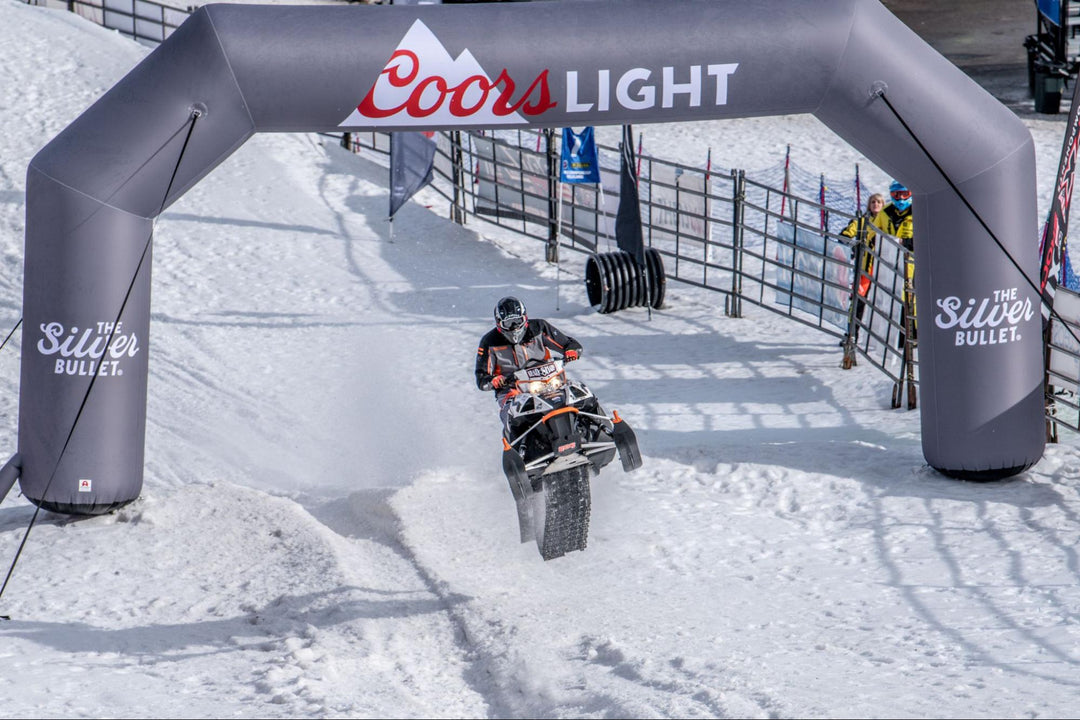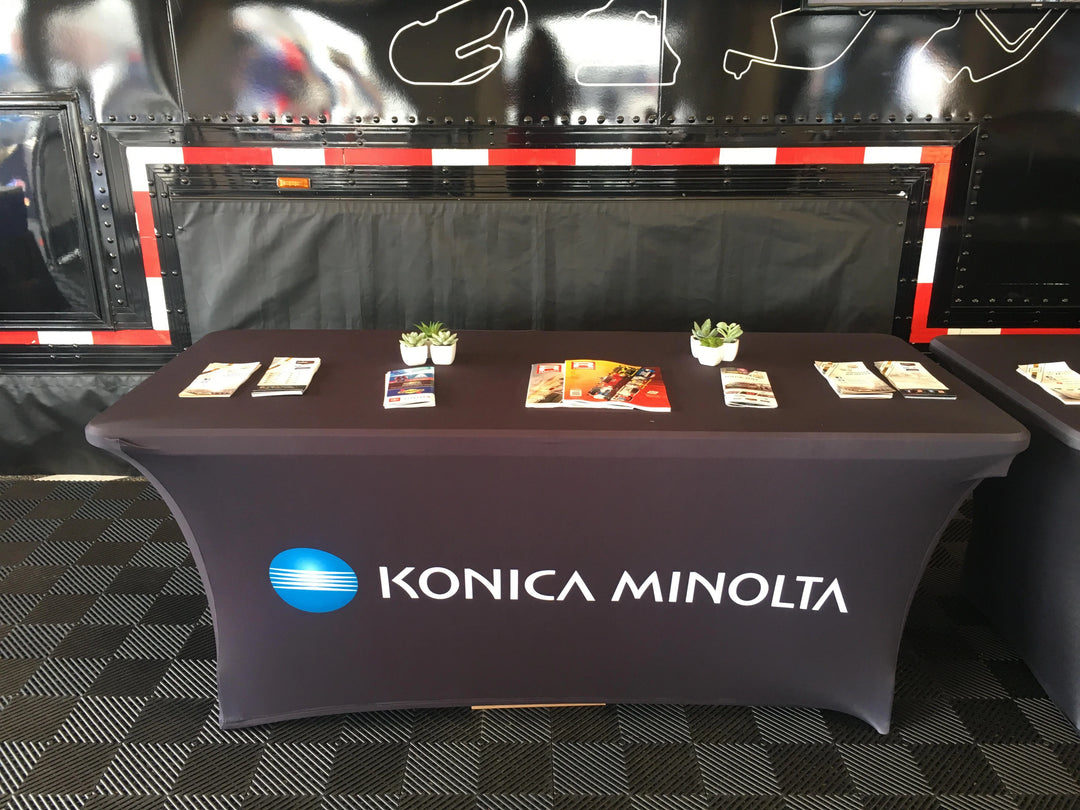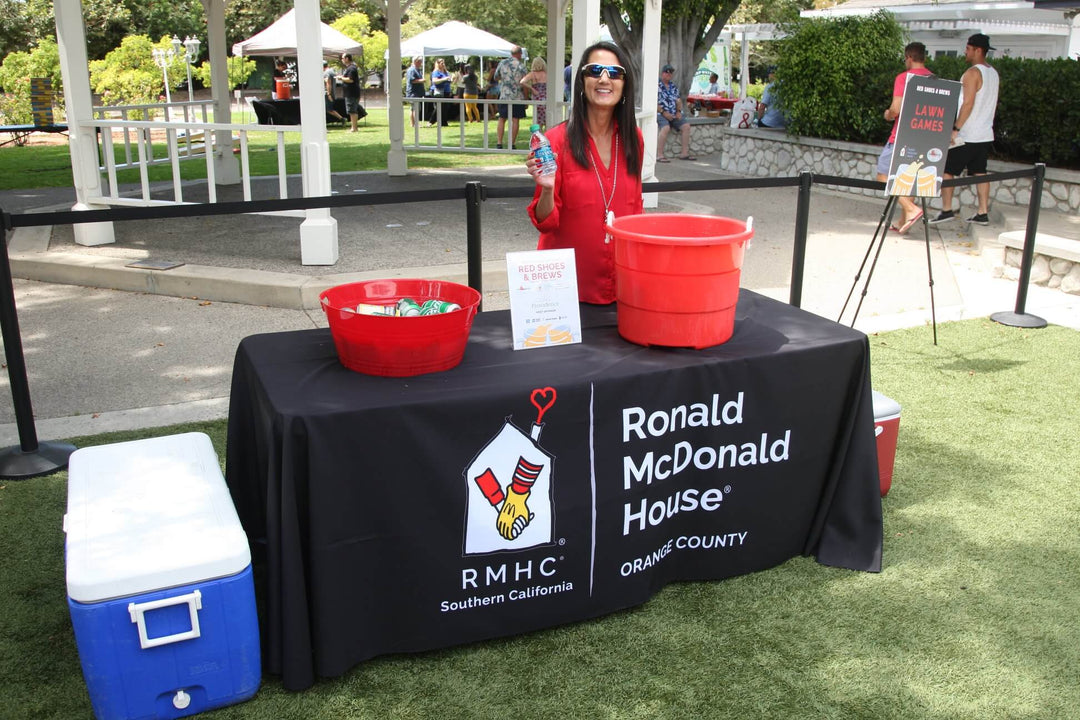The word 'sign' originates from the Latin 'signum' - a mark, token, or indication.
In ancient Rome, 'tabernae,' small shops or stalls where various goods and services were sold, would often proudly display signs or symbols outside to signify the type of business conducted within. For instance, a shop selling wine might hang a sign featuring a grapevine, a practice that laid the foundation for the enduring tradition of businesses using distinctive signs to attract and inform customers.
From these ancient roots evolved a vital element of modern commerce: the business sign, acting as a beacon to draw in customers. The benefits of effective signage are not just anecdotal; they are backed by scientific research and data.
A study by the University of Cincinnati revealed the tangible value of effective signage, finding that nearly 60% of businesses saw a positive impact on sales, number of transactions, and profits, averaging an increase of about 10%, simply by enhancing the design or visibility of their signs.
Additionally, FedEx's research underscores the power of a sign's first impression: nearly 76% of consumers have stepped into a store they had never visited before based on its signs, and approximately 68% have made purchases influenced by the allure of signage.
Given these impactful findings, it's no wonder that the global sign market is a booming industry, projected to grow from $116.07 billion in 2022 to $123.54 billion in 2023.

Perhaps the most recognizable business signage in the world, McDonald's golden arched "M" sign has served as an iconic beacon since the 1960s, pioneering ambitious, impactful commercial signage that set the standard for businesses to build massive brand awareness.
Join us as we navigate the world of business signs. We'll examine a range of business sign types, uncovering their unique functions, benefits, and use cases, to guide you in selecting the perfect signage for your business needs.
Whether you're a small café looking to charm passersby or a corporate juggernaut aiming for high-impact brand visibility, understanding the nuances of different signs can transform your approach to business visibility.
By the end of this article, you’ll not only be familiar with various sign types but also be equipped with the knowledge to select the right one that resonates with your business and meets your marketing objectives.
Advertising Flags
MVP Visuals create customizable advertising flags that allow businesses to prominently showcase their branding at outdoor events.
Advertising flags are eye-catching, versatile signs ideal for both indoor and outdoor promotional activities. Made from durable, lightweight materials, these flags are designed to wave in the breeze, capturing attention with their movement.
The benefit of using advertising flags lies in their ability to stand out in busy environments, making them perfect for attracting potential customers and announcing special events or offers.
Types of Advertising Flags
- Feather Flags: Tall and narrow, resembling a feather, effective for high visibility from a distance.
- Teardrop Flags: Shaped like a teardrop, offering more space for messaging and stable in wind.
- Rectangle Flags: Providing a traditional flag shape with ample space for logos and text.
- Car Flags: Small flags mounted on cars, ideal for mobile advertising or brand promotion.
Pros
- High Visibility: Their height and movement make them noticeable even in crowded or busy areas.
- Portability: Easy to set up, move, and store, making them ideal for temporary events or promotions.
- Customizable: Can be printed with any design, logo, or message, allowing for brand consistency.
- Cost-Effective: Compared to many other forms of advertising, flags are relatively inexpensive.
Cons
- Weather Dependent: Their impact can be reduced in poor weather conditions, particularly if there's no wind to keep them fluttering.
- Limited Space for Message: Due to their shape and size, the message or design needs to be concise and visually impactful.
- Wear and Tear: Frequent outdoor use can lead to fading or damage, necessitating replacement over time.
Business Use Cases
- Ideal for retail stores to increase foot traffic
- Effective for restaurants and cafes to promote daily specials
- Suitable for event promotion, like fairs and outdoor markets
- Beneficial for businesses in high-traffic areas to attract distant attention
Banners
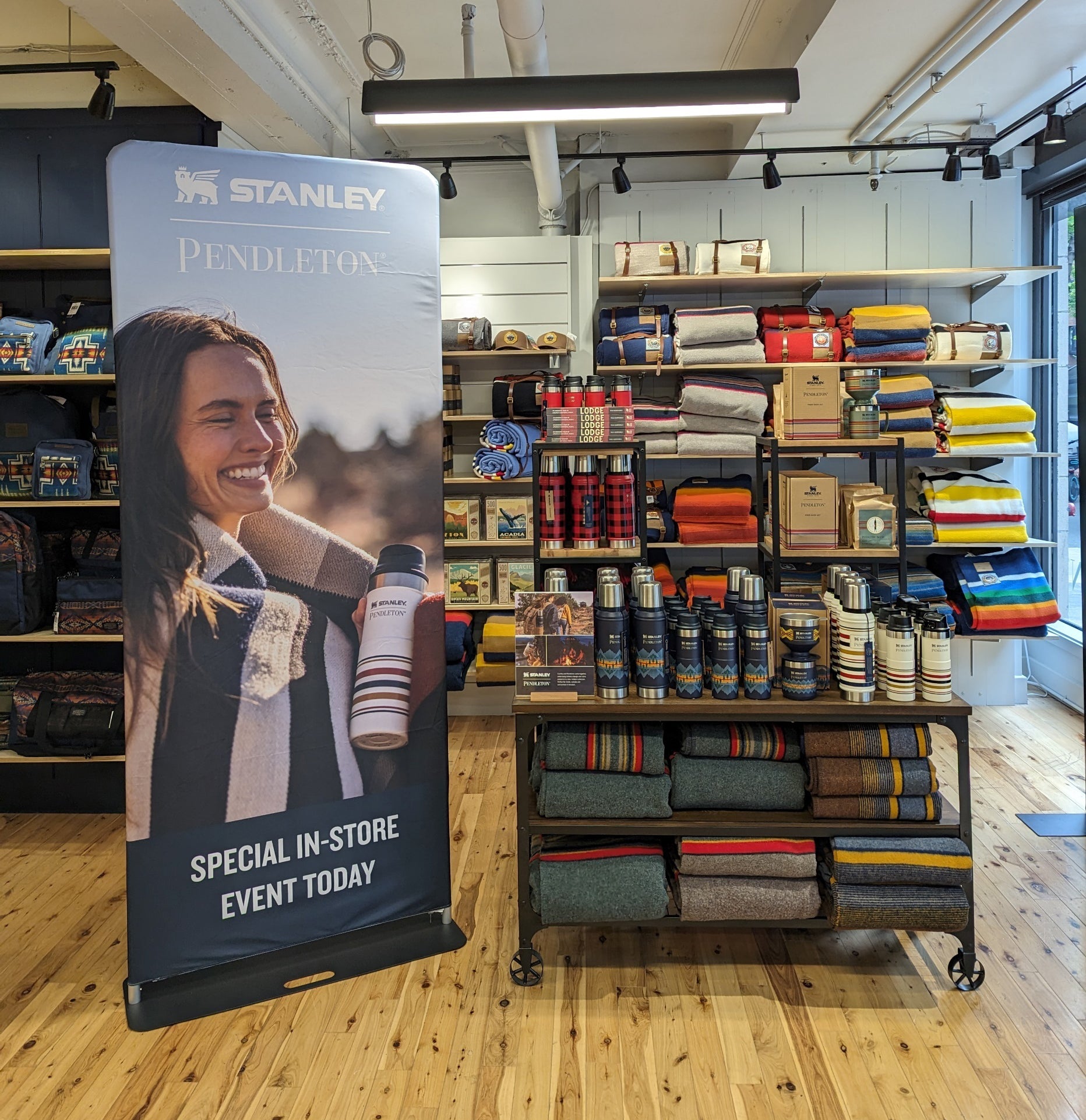
Banners are versatile and highly visible promotional tools used in a variety of settings, from trade shows to storefronts. Made from durable materials like vinyl or fabric, they are designed for both indoor and outdoor use.
Like a peacock's feathers, banners stand out boldly, flaunting your brand's message in the most visually striking way possible. Their adaptability and effectiveness in conveying brand messages or promotions make them an essential tool in any marketer's arsenal, combining visual impact with practicality.
Types of Banners
- Roll-Up/Retractable Banners: Portable and easy to set up, ideal for trade shows, conferences, and indoor events.
- Slip Sign Banners: Designed to slip over existing frames, perfect for seasonal promotions or temporary advertising.
- Step and Repeat Banners: Used as backdrops for photo opportunities, commonly seen at events and red carpets.
- Vinyl Banners: Durable for outdoor use, often hung on buildings, fences, or between posts.
- Mesh Banners: Ideal for windy conditions, with a mesh design that reduces wind resistance.
- Pole Banners: Mounted on light poles or across streets, commonly used for community events or downtown advertising.
Pros
- Large surface area for prominent messaging and visuals
- Durable and suitable for both indoor and outdoor use
- Easy to install and transport
- Customizable for specific events or branding needs
Cons
- May require additional hardware for proper display
- Can be susceptible to damage from extreme weather conditions
- Larger banners may require more storage space
Business Use Cases
- Retail stores using banners for sales promotions or brand awareness
- Companies at trade shows and exhibitions showcasing their brand or products
- Event organizers using step and repeat banners for photo opportunities and branding
- Businesses using roll-up/retractable banners for portable, easy-to-set-up advertising at various locations
- Organizations using slip sign banners for temporary or seasonal promotions
Billboard Signs
 Originating in the 19th century, billboard signs marked the beginning of outdoor advertising. Initially featuring hand-painted ads for products and events, they gradually became a defining feature of the urban landscape.
Originating in the 19th century, billboard signs marked the beginning of outdoor advertising. Initially featuring hand-painted ads for products and events, they gradually became a defining feature of the urban landscape.
Billboard signs are large outdoor advertising structures typically found in high-traffic areas such as highways, busy streets, or urban centers. Their primary benefit lies in their size and location, which offer high visibility to a large audience, making them an effective tool for mass marketing and brand exposure.
Billboards are designed to capture the attention of both pedestrians and drivers, making them ideal for broad-reaching advertising campaigns.
Types of Billboard Signs
- Static Billboards: Traditional billboards with fixed imagery, often used for longer-term advertising campaigns.
- Digital Billboards: Electronic displays that can show rotating advertisements, offering the flexibility of changing content.
- Mobile Billboards: Mounted on vehicles, these billboards can move around, targeting specific locations or events.
- Three-Dimensional Billboards: Incorporate three-dimensional elements or physical extensions to create a more impactful visual experience.
- Eco-Friendly Billboards: Utilizing sustainable materials or solar-powered lighting to reduce environmental impact.
Pros
- Exceptionally high visibility and audience reach.
- Effective for brand awareness and promotional campaigns.
- Digital billboards offer the flexibility of time-sensitive or rotating advertisements.
- Can be targeted based on location to reach a specific demographic.
Cons
- Generally more expensive than other forms of advertising signages.
- Subject to strict regulations and zoning laws in many areas.
- Static billboards require a longer commitment to a single message or campaign.
- Environmental concerns, particularly with traditional illuminated billboards.
Business Use Cases
- National brands seeking to increase brand awareness on a large scale.
- Local businesses aiming to attract customers from specific geographic areas.
- Companies launching major advertising campaigns or promoting special events.
- Businesses looking to make a bold statement or leave a lasting impression on a wide audience.
Building Mounted Signs

Commercial building-mounted signs are affixed directly to the exterior of a commercial building or structure, serving as a key element in business branding and customer attraction. They are designed to be visible from a distance, align with the architectural aesthetics of the building, and effectively convey the business's identity.
These signs excel in creating a strong, noticeable presence in a business's immediate area, proving ideal for storefront identification and brand promotion.
Types of Building Mounted Signs
- Blade Signs: Projecting signs mounted perpendicularly to the building, highly visible to pedestrian traffic.
- Channel Letter Signs: Individual letters or designs that are often illuminated, offering a clean and modern look.
- Awning Signs: Integrated into an awning, providing both signage and shelter, suitable for cafes, boutiques, and other storefronts.
- 3D Signs: Three-dimensional signs that add depth and impact, often used for logos or business names.
- Illuminated Signs: Include various forms of lit signage like backlit panels or neon signs, enhancing visibility during night-time.
- Hanging Signs: Smaller signs that hang from a bracket, visible to pedestrians, commonly used by small businesses or in historic districts.
Pros
- Enhances brand visibility and recognition.
- Can be tailored to complement the building's architecture.
- Variety of types and designs to choose from.
- Illuminated options improve visibility in low-light conditions.
Cons
- May require permits and adherence to local zoning laws.
- Installation can be more complex and costly than freestanding signs.
- Maintenance and potential impact on the building's facade.
Business Use Cases
- Retail stores and restaurants using blade signs for easy identification by passersby.
- Corporate buildings and franchises opting for channel letter signs for a sleek, professional look.
- Small businesses and cafes utilizing awning signs for dual functionality and charm.
- Companies seeking a bold, modern appearance with 3D signs.
- Businesses that operate during evening hours using illuminated signs for 24/7 visibility.
Decals

Decals are adhesive graphics used on various surfaces for promotional or branding purposes. They come in various forms, such as window decals and vehicle decals, and offer a flexible and cost-effective way to display messages or branding. Decals stand out for their versatility and ease of use, enabling businesses to effectively turn everyday spaces and vehicles into impactful marketing tools.
Types of Decals
- Window Decals: Applied to glass surfaces, these are perfect for storefronts, business windows, or doors to display business hours, logos, or promotional information.
- Vehicle Decals: Used on cars, trucks, or other vehicles, these transform a vehicle into a mobile billboard, spreading a business's message wherever it goes.
- Floor Decals: Designed for floors, these can guide customers, promote social distancing, or advertise in unique locations.
- Wall Decals: Used on walls for decorative or branding purposes, easily removable and great for temporary promotions or interior branding.
- Static Clings: Non-adhesive decals that can be easily placed and removed from glass surfaces, ideal for temporary or seasonal promotions.
Pros
- Highly customizable with various designs, sizes, and colors.
- Easy to apply and remove, offering flexibility in advertising.
- Cost-effective compared to more permanent signage solutions.
- Effective in increasing brand visibility and awareness in different environments.
Cons
- Limited durability, especially in outdoor conditions.
- Visibility can be affected by the placement and lighting conditions.
- May require professional installation for large or complex designs.
Business Use Cases
- Retail stores using window decals for storefront promotions or branding.
- Service companies leveraging vehicle decals for mobile advertising and brand recognition.
- Businesses in high-traffic areas using floor decals for directional purposes or advertising.
- Offices or commercial spaces using wall decals for temporary campaigns or interior decor.
Digital Signs

Digital signs, encompassing LED, LCD, and interactive touchscreen displays, offer a dynamic and modern approach to signage. They stand out for their ability to display vibrant, changing content that can engage and inform viewers in real time.
A major advantage of digital signage is its flexibility; content can be updated quickly and remotely, making it ideal for timely messaging and interactive customer engagement.
Types of Digital Signs
- LED Signs: Known for their brightness and energy efficiency, ideal for both indoor and outdoor use.
- LCD Signs: Commonly used for indoor applications, offering high-resolution displays suitable for detailed content.
- Interactive Touchscreen Displays: Enable direct interaction with the content, enhancing customer engagement and experience.
- Digital Billboards: Large-scale digital displays used for high-impact advertising in outdoor settings.
- Digital Menu Boards: Used primarily in restaurants and cafes for displaying menus and specials.
- Information Kiosks: Interactive displays that provide information, wayfinding, and can even facilitate transactions.
Pros
- High-resolution displays capture attention effectively
- Ability to update content remotely and in real time
- Interactive options enhance customer engagement
- Energy-efficient, especially with LED technology
Cons
- Higher initial investment compared to traditional signage
- Requires consistent power supply and potential maintenance
- Can be less visible in direct sunlight (especially LCD screens)
Business Use Cases
- Retail stores utilizing dynamic content to showcase products and offers
- Restaurants updating menus and specials digitally
- Corporates and educational institutions using interactive signs for information and wayfinding
- Businesses in high-traffic areas leveraging bright LED signs for maximum visibility
Directional Signs

Directional signs are essential for guiding visitors and customers through various environments, such as business complexes, shopping centers, hospitals, and educational campuses.
These signs improve navigation by clearly marking pathways, entrances, exits, and key areas. Directional signs enhance the user experience by making navigation intuitive and straightforward, a crucial aspect in large or complex spaces.
Types of Directional Signs
- ADA Compliance Signs: Specifically designed to meet the Americans with Disabilities Act standards, these signs include braille and high-contrast visuals to aid navigation for all individuals, including those with disabilities.
- Wayfinding Signs: Encompass a broader range of signage used to guide people through spaces. These can include maps, directional arrows, and signs that indicate specific locations like restrooms, parking areas, and different departments within a building.
- Informational Signs: Provide visitors with necessary information about the premises, such as rules, regulations, or historical facts.
- Identification Signs: Used to identify specific rooms, areas, or buildings within a larger complex.
Pros
- Enhances visitor experience by providing clear directions.
- Helps in maintaining an organized flow of traffic within a space.
- Essential for accessibility, especially with ADA compliance signs.
- Can be customized to align with the aesthetic of the business or space.
Cons
- Must be strategically placed for effectiveness, requiring careful planning.
- ADA compliance signs require adherence to specific standards and regulations.
- Frequent updates might be needed in dynamic environments like shopping centers or hospitals.
Business Use Cases
- Healthcare facilities and hospitals using wayfinding signs for efficient patient and visitor navigation.
- Educational institutions like universities and schools employ a combination of informational and identification signs.
- Large corporate offices or industrial parks using directional signs to guide visitors and employees.
- Public spaces like museums and parks utilizing ADA compliance signs for inclusive accessibility.
Freestanding Outdoor Signs
Freestanding outdoor signs are standalone structures designed to capture attention in various outdoor settings. These signs are not attached to any building, making them versatile for placement in strategic locations like roadways, business entrances, or parking lots.
Highly visible and capable of reaching a broad audience, freestanding outdoor signs excel in reinforcing brand identity and providing directional guidance.
Types of Freestanding Outdoor Signs

The famous Hollywood monument sign originated in 1923 as an advertisement for a local real estate development and has endured as an iconic pop culture symbol at the gateway to Tinseltown.
- Monument Signs: Low-profile, ground-level signs often used at the entrances of businesses, parks, and corporate campuses.
- Pylon Signs: Tall signs, often illuminated, ideal for attracting attention from a distance, such as near highways or large shopping centers.
- Totem Signs: Similar to pylons but often featuring more architectural elements and design, used as landmark signs for businesses or areas.
- Post Signs: Signs mounted on one or more posts, versatile for various locations, including business frontages or roadside advertising.
- Marquee Signs: Often associated with theaters or entertainment venues, these signs can be digital or traditional, providing information and attracting attention.
Pros
- High visibility to a broad audience.
- Variety in size and design to suit specific branding needs.
- Effective for long-term branding and directional information.
- Can be illuminated for night-time visibility.
Cons
- May require significant investment, especially for larger or custom-designed signs.
- Subject to zoning regulations and permits in many areas.
- Permanent or semi-permanent, limiting flexibility in changing promotions.
Business Use Cases
- Retail centers and shopping malls using pylon signs for collective business advertising.
- Corporate offices and industrial parks using monument signs for a professional entrance display.
- Entertainment venues like theaters or concert halls using marquee signs for event promotion.
- Businesses requiring directional signage within larger complexes or campuses.
Inflatables
MVP Visuals crafted an impactful inflatable product replica of the Moment beverage can, which grabbed attention during its feature on Shark Tank.
Advertising inflatables are large, often colorful advertising structures designed to catch the eye of passersby. Commonly used for promotions and special events, these signs can take various forms, including product replicas, mascots, arches, and more.
They create a significant visual impact and generate excitement or curiosity, making them ideal for attracting attention in various settings, from trade shows to storefronts.
Types of Inflatables
- Product Replicas: Large-scale inflatable versions of products, perfect for promoting new launches or popular items.
- Mascots and Characters: Custom-designed inflatables shaped like company mascots or characters, engaging for a younger audience or for brand recognition.
- Inflatable Arches: Used at event entrances or race start/finish lines, offering high visibility.
- Sports Inflatables: Inflatable football tunnels shaped like football helmets or team mascots provides a thrilling entrance for players and fans to kick off the game with dynamic energy and team pride.
- Advertising Blimps: Floating inflatables that can be seen from a great distance, excellent for large outdoor events or areas.
Pros
- Eye-catching and unique, providing a novel way to attract attention.
- Customizable in various shapes, sizes, and designs.
- Portable and relatively easy to set up and dismantle.
- Effective for both indoor and outdoor promotional activities such as sporting evens and trading shows
Cons
- Weather-dependent; may not be suitable for use in high winds or extreme weather conditions.
- Requires a power source for inflation.
- Space requirements can be significant, depending on the size.
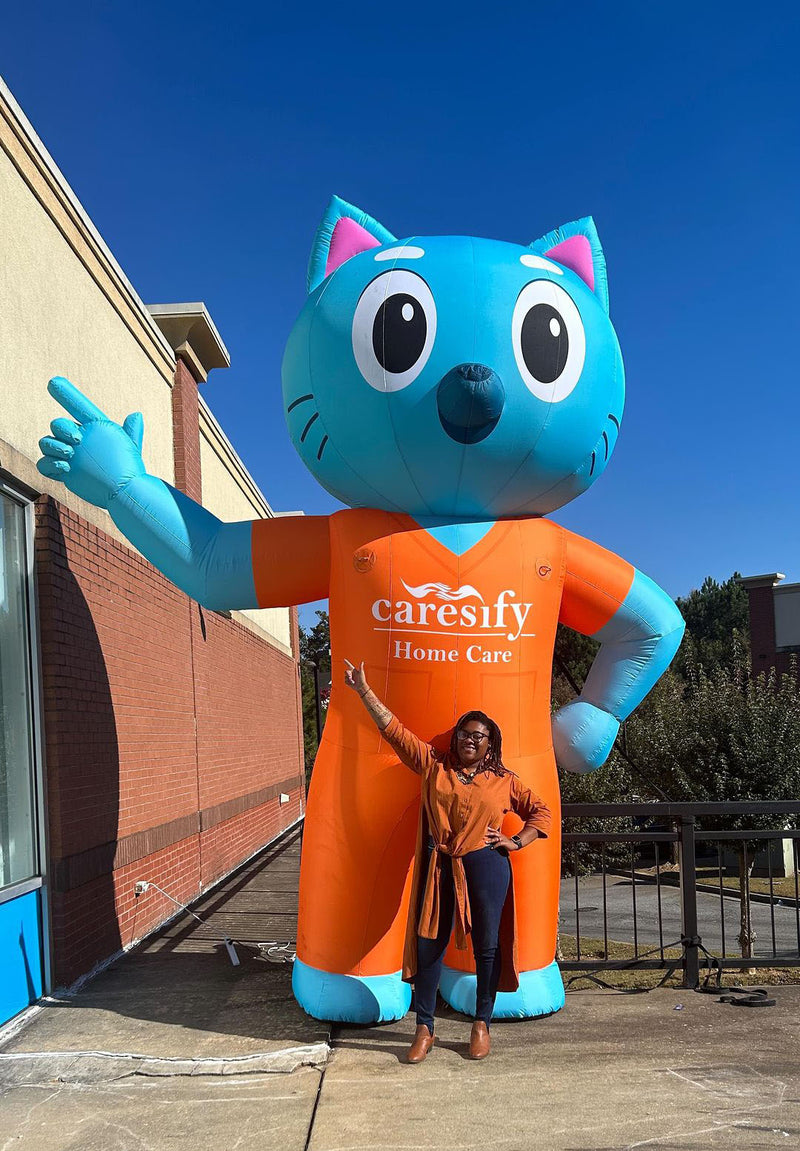
Business Use Cases
- Retail stores using product replicas to highlight specific products or sales.
- Companies at trade shows and expos using branded mascots or characters for brand engagement.
- Event organizers employing arches and tunnels for races, fairs, and community events.
- Businesses in high-traffic areas utilizing advertising blimps for wide-reaching visibility.
POP (Point of Purchase) Displays
Point of Purchase (POP) displays are marketing materials placed near the merchandise they are promoting, typically found in retail environments. These displays are designed to attract customers' attention at the very place and time they are making purchase decisions.
The primary benefit of POP displays is their effectiveness in driving impulse buys and highlighting specific products, which can significantly increase sales and product visibility.
Types of POP Displays
- Counter Displays: Small units placed on counters or checkout areas, ideal for small items or impulse purchases.
- Floor Displays: Larger, freestanding units positioned on the retail floor, often used for special promotions or featured products.
- Shelf Talkers: Small signs attached to shelves, drawing attention to specific products and providing additional information.
- Endcap Displays: Located at the end of aisles, these are highly visible and can be used to promote special offers or new products.
- Interactive Displays: Include digital or mechanical elements that engage customers, providing an interactive shopping experience.
Pros
- Directly influences purchasing decisions at the point of sale.
- Customizable to fit the product and branding strategy.
- Enhances product visibility and differentiation in a retail setting.
- Can be tailored for seasonal promotions or new product launches.
Cons
- Requires space within the retail environment, which might be limited.
- Design and production can be more complex and costly than standard signage.
- May require regular updates or changes to align with current promotions.
Business Use Cases
- Retailers looking to boost sales of specific products or product lines.
- Brands launching new products and wanting to maximize visibility in stores.
- Stores seeking to enhance customer engagement with interactive or thematic displays.
- Businesses aiming to capitalize on holiday seasons or special events with themed promotions.
Roadside Signs

Roadside signs are a diverse group of signage solutions designed for maximum visibility along streets, roads, and other outdoor settings. They are key tools for attracting the attention of drivers and pedestrians alike. Roadside signs excel in reaching a broad audience, effectively conveying messages or promotions directly to people on the move.
Types of Roadside Signs
- Yard/Curb Signs: Small, portable signs typically made of corrugated plastic, placed on lawns or near the roadside.
- A-Frame/Sandwich Boards: Freestanding, foldable signs that are easy to set up on sidewalks or outside businesses.
- Pole Signs: Tall signs mounted on a pole, designed to be seen from a distance, often used by businesses with setbacks from the road.
- Sidewalk Signs: Smaller signs that can be placed directly on the sidewalk, ideal for cafes, restaurants, and small retail stores.
Pros
- High visibility to passersby and motorists
- Variety of types and sizes to suit different needs and locations
- Can be strategically placed for targeted local advertising
Cons
- May require permits or adherence to local regulations
- Some types can be affected by weather conditions
- Limited space on certain types for detailed messaging
Business Use Cases
- Ideal for local businesses like restaurants, salons, and retail stores to attract nearby foot and vehicle traffic.
- Real estate agents using yard signs for property listings.
- Event organizers promoting events with strategically placed road sign signs.
Street Furniture Signs

Street furniture signs are a type of outdoor advertising that appears on public fixtures like bus shelters, park benches, kiosks, and waste bins. These signs are integrated into the daily lives of pedestrians and commuters, offering high visibility in urban and suburban areas. The key benefit of street furniture signs is their ability to reach a wide audience in a variety of settings, making them ideal for local and community-focused advertising.
Types of Street Furniture Signs
- Bus Shelter Ads: Advertisements placed on or inside bus shelters, providing visibility to both commuters and pedestrians.
- Bench Signs: Integrated into public seating areas, often in parks or along sidewalks.
- Kiosk Displays: Found on information or advertising kiosks in high-foot-traffic areas, such as downtown streets or near tourist attractions.
- Waste Bin Ads: Advertisements placed on public trash receptacles, combining utility with marketing.
- Bicycle Rack Signs: Incorporating advertising with public bicycle parking facilities, often found in urban areas.
Pros
- Continuous exposure in high-traffic areas, enhancing brand visibility.
- Targets local audiences effectively, ideal for businesses focusing on community outreach.
- Diverse range of advertising options to suit different environments and budgets.
- Often viewed as a public service, especially when providing shelter or seating.
Cons
- Limited space and size for advertising messages.
- Subject to weather conditions and potential vandalism.
- Requires coordination with local authorities or private entities for placement.
Business Use Cases
- Local businesses looking to increase their presence in the community.
- Companies aiming for consistent visibility in urban areas.
- Brands focusing on targeted advertising campaigns in specific neighborhoods or regions.
- Businesses seeking to reinforce their local community involvement or environmental commitment.
Tabletop Displays
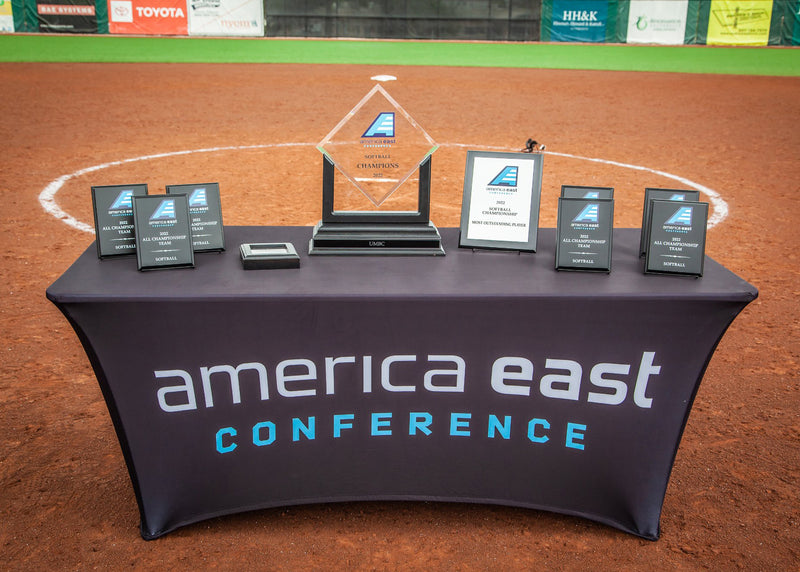
MVP Visuals craft custom-made table covers to provide businesses vibrant, full-coverage branding opportunities.
Tabletop displays are compact, portable displays designed for use on tables or counters, commonly seen at trade shows, conventions, retail spaces, and business meetings. Their primary benefit is their ability to convey information or promote products in a direct and personal manner, right where potential customers or clients are engaged.
These displays are ideal for highlighting specific products, showcasing services, or providing detailed information in an accessible and space-efficient manner.
Types of Tabletop Displays
- Pop-Up Displays: Easily assembled frameworks that can be adorned with custom graphics, perfect for trade show booths or presentations.
- Literature Stands: Designed to hold and display brochures, flyers, or business cards, helping to organize and distribute marketing materials effectively.
- Table Covers: Custom-branded tablecloths or runners that enhance the overall appearance of the display area.
- Interactive Kiosks: Small digital displays or touchscreens that provide interactive experiences for viewers.
Pros
- Highly portable and easy to set up and dismantle.
- Customizable with brand logos, messages, and graphics.
- Direct engagement with customers or clients at close proximity.
- Versatile for a variety of settings, from business events to retail spaces.
Cons
- Limited space for displaying information and graphics.
- Can be less visible in crowded or spacious venues.
- Requires a table or counter for proper setup.
Business Use Cases
- Companies participating in trade shows and exhibitions to showcase their products or services.
- Retail stores using tabletop displays for in-store promotions or product highlights.
- Businesses at networking events or conferences to provide information or gather leads.
- Restaurants or cafes utilizing tabletop displays for menu specials or event promotions.
Sign Off on the Right Note
To wrap up our tour of various business sign types, we hope this guide has helped you learn about different signs and their purposes, enabling you to make an educated decision in choosing the perfect signage for your business.
Remember, the right sign not only speaks volumes about your brand but also bridges the gap between your business and potential customers.
Whether it's the vibrant movement of advertising feather flags, the custom appeal of custom banners, or the dynamic allure of a digital display, your choice in signage is a reflection of your business's unique identity.
Choose wisely, and watch as your business signage transform from a mere marker to a landmark in its own right, much like the iconic golden arches of McDonald's, which have become more than just a sign but a global symbol recognized everywhere.

